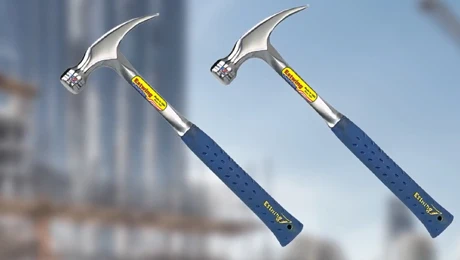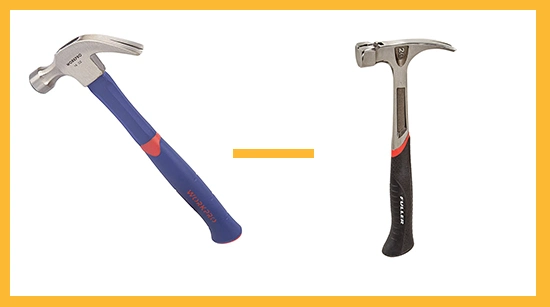Last Updated on January 10, 2023
As a DIY enthusiast or a professional carpenter, you need a new hammer, but you want to buy a manageable size, as the wrong size hammer could easily damage the workpiece. In this circumstance, a 16oz or 20oz hammer could be a good choice for you.
Even though each has unique characteristics and applications, the most significant difference between them is their weight. The added weight of the 20oz hammer can give more power behind a swing, which makes driving nails into hardwood easier.
These two hammers are the most prevalent sizes for carpentry but choosing the right one can matter when it comes to the quality of one’s work. Here we will provide the main differences between 16oz and 20oz hand tools and their pros & cons. Afterward, you can decide which one is more suitable for you.
Comparisons Between 16oz vs 20oz Hammer

A 16oz hammer and a 20oz hammer will have some differences in terms of how they perform, which will be highlighted below:
Hammer Weight:
The apparent difference between a 16oz & 20oz hammer is the weight of each one. A 16oz hammer typically weighs 1lb, while a 20oz hammer weighs 1.25 lbs, which makes it approximately 25% heavier than its 16oz counterpart.
This extra weight makes the 20oz version better suited for heavier tasks, such as driving large nails into dense materials or tackling tougher projects with hard-to-drive fasteners.
Hammer Size:
In terms of hammer size, 16 oz and 20 oz hammers measure roughly 12 inches in length, but they may vary slightly in width and thickness depending on their specific design.
The extra quarter pound of weight gives the 20oz model a slightly larger footprint when compared to its lighter counterpart, making it more challenging to maneuver in tight spaces or when using precise strikes with limited swing space available.
Head Design:
The head of both 16-ounce and 20-ounce hammers are designed differently, each having certain advantages depending on what job you need to tackle.
Generally speaking, 16 oz hammers feature more slender heads with smaller striking faces, while 20 oz hammers have thicker heads and larger striking faces. Both allow users to apply greater force when driving nails into harder surfaces like concrete or masonry walls.
Also, many 20 oz claw hammer models have additional features like checkered faces or magnetic nail holders that make them better suited for repetitive tasks or working in confined spaces where precision is key.
Handle Design:
Another critical distinction between 16oz and 20 oz models is their handle designs. It is common for manufacturers to create 20 oz hammers with longer handles since they are heavier than their lighter 16oz counterparts. This provides better leverage when pounding large nails into hard materials like wood or stone.
Compared to a lighter 16oz version with shorter handles, users can exert more force using a 20oz hammer longer handle without using as much energy.
Plus, some manufacturers also include grips on their 20oz hammer handles that prevent slippage during heavy use, making them ideal for prolonged use over extended periods without sacrificing comfort and control in the hands of the user.
Usages:
As mentioned earlier, hammers of 16 and 20 ounces can be used for different jobs depending on what task you intend to do with them. From light carpentry work to heavier applications involving denser hammer materials such as masonry walls or concrete floors/sidewalks.
But, due to its added weight, a 20 oz claw hammer model will usually be better suited to more demanding tasks because a 20oz claw hammer can deliver greater force behind each strike thanks to its increased mass.
A 16 oz hammer provides greater control over individual strokes because of its lighter weight and maneuverability, ideal for tasks such as installing trim moldings around doors or windows.
Price:
There are also price differences between these 16 oz and 20 oz hammers which depend on the brand name of each model. Typically you’ll find that higher-quality brands charge more money for their products than lesser-known ones, regardless of which size you buy.
Even so, even an average-sized, high-quality 20 oz hammer is likely to cost slightly more than its lighter counterpart. This is primarily due to its increased weight, larger size, & additional features.
Similarities of 16oz and 20oz Hammer

The 16oz and 20 oz hammers are popular tools that can be used for various purposes, from hanging pictures to construction projects. Despite the difference in size, these two hammer types have some similarities.
Construction Material:
Both the 16-ounce and 20-ounce hammers are typically made from hardened steel or forged steel, which makes them highly durable and resistant to wear and tear.
Also, they are designed with a rugged rubber handle that provides a comfortable grip while hammering. While steel is the most common material, some hammers may also be made from aluminum, which is lighter but less durable.
Portability:
The 16 and 20-ounce hammers are lightweight and small compared to other models, so they can easily be carried around in tool boxes or bags when needed. This makes them ideal for DIYers who require portability in their projects.
But the 16oz hammer is slightly lighter than the 20oz hammer, making it even easier to transport. They also have a built-in handle that can hang them up when not in use.
Ease of Use:
The 20 oz and 16 oz hammers are easy to use as they feature a balanced weight distribution that helps keep them stable. This also helps reduce fatigue from prolonged use as there is less stress on the arms or wrists when using either type of hammer.
Plus, the handles of 16 oz and 20 oz hammers are designed to be comfortable to hold and provide enough leverage to swing without straining your arms or back muscles.
You Can Also Check: How do 20 oz hammers compare to 16 oz hammers?
Pros and Cons of Using 16oz vs 20oz Hammer

When deciding between a 16oz and 20oz hammer for use on a job site, both styles have distinct pros and cons that should be considered before making a purchase:
Pros of the 16oz Hammer:
A 16oz hammer is lightweight, making it easy to maneuver and handle for extended periods. Its smaller head allows more precise contact with the surface being hammered, so you can easily break apart small objects and tiles without damaging valuable material.
Its shorter handle helps limit fatigue on arms and hands, helping to reduce overall strain while working. The smaller size also makes it easier to store than larger hammers, making it an ideal choice for people who don’t have much storage space or need a hammer occasionally.
Cons of the 16oz Hammer:
While lighter weight makes a 16 oz hammer style better suited for precision work or smaller tasks, it may not be as good at handling heavier-duty work like driving nails into lumber or breaking up large pieces of concrete.
You may find that you need to use more force for a 16oz hammer than with a heavier-duty 20oz hammer to get results, which can lead to fatigue quicker than if you were using a larger head and longer handle.
Pros of the 20oz Hammer:
Due to its heavier weight, this 20oz style provides more power when swinging, so you can complete heavy-duty projects faster. The wider head also gives you more significant surface area contact when striking materials, allowing you to break down large objects in fewer swings.
Also, the longer handle provides more torque power, enabling you to drive nails deeper into the wood without needing as much effort. This makes the 20oz hammer ideal for construction projects involving larger pieces of lumber where extra power is needed for successful completion.
Cons of the 20oz Hammer:
This 20 oz style requires additional strength to effectively use due to its weight and heftier design, which could be problematic for novice users or those with limited upper body strength/mobility issues.
Some users may also lose accuracy when using the 20oz model because they cannot control their strikes due to its size and weight compared with a lighter model like the 16oz option mentioned above.
The larger size also means that storage is more challenging than smaller models, which could be an issue depending on available space or mobility needs between job sites if used frequently away from home base.
Topics of Interest: A comparison of demolition hammers and rotary hammers
Precautions When Using 16 Oz and 20 Oz Hammer?

When working with a 16 or 20-oz hammer, you must take proper safety precautions to protect yourself from potential injuries. Here are some safety tips and guidelines for handling 16 oz and 20 oz hammers to ensure workplace safety and maximize protection.
- Always wear protective gear when using a 20 or 16-oz hammer. Make sure you wear gloves, goggles, and steel-toe footwear that can absorb shocks caused by heavy blows when using the hammer.
- Ensure your 16-oz or 20-oz hammer’s handle is attached adequately before use. Check for signs of damage like splintering wood or corrosion on the metal parts of your hammer head and handle before you begin any job.
- Keep a firm grip on the hammer handle when striking with a hammer. Loose grips can lead to slips and misdirected blows that may cause injury or even destroy other objects in the work area.
- Always ensure you have a secure grip on the 16 or 20-ounce hammer handle when starting with a blow and during the follow-through motion to prevent misdirected strikes from occurring due to slipping hands.
- Make sure that all parts of your body are away from the target object when making strikes by using a 16 or 20-ounce hammer so that accidental contact does not occur if you miss your intended target or if sparks or flying debris occurs due to striking too hard.
- Remember how much force is required for specific tasks while using a 16-oz or 20-oz hammer so that you don’t accidentally overcompensate with your swings by putting too much strength into each strike resulting in unintended destruction of materials.
- Always ensure space around you while operating 16oz and 20 oz hammers since objects like furniture can easily be damaged if they come into contact with uncontrolled swinging motions.
- When storing 16 oz & 20 oz hammers between uses, ensure they are secured safely away from areas where children, pets, or unsuspecting visitors may experience hardship from their presence, such as tripping hazards, etc.
Are 20 oz Heavier Hammers Better than 16 oz Hammers?
A 16oz claw hammer is suitable for general light-duty household projects while a 20oz should be used only when extra power and force are needed for tough tasks like demolishing drywall or driving large nails into tough material like concrete blocks.
If you’re working in overhead locations or on delicate projects such as furniture repair, a lighter hammer won’t cause as much damage or deformity of material as an overly hefty one would.
So, when it comes to 16 oz & 20 oz hammers, choosing the right size is essential for getting the job done safely and efficiently. Both sizes have advantages and disadvantages, so find the one that best fits your needs and ensure proper safety precautions when using any hammering tool.
Topics of Interest:



